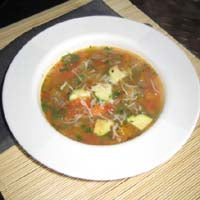The Clock-Stopping Power of Fiber
By Cheryl Forberg
Most of us know that we need fiber in our diets, but bran cereal isn’t our only option. While it’s recommended that most adults consume 25 to 35 grams of fiber a day, the typical American eats only half this amount or less.
That’s unfortunate, since fiber helps protect us from colorectal cancer while reducing the risk for heart disease. Additionally, fiber gives a feeling of satiety, which means it makes you feel full. The best way to get more fiber is to serve yourself more whole grains, fruits, vegetables, and other complex carbohydrates. If you’re unaccustomed to eating high fiber foods, you may want to add fiber to your diet gradually. This allows you to avoid abdominal consequences (bloating and/or gas) that can occur if you introduce too much fiber too fast.
Another added health bonus from high fiber fruits and vegetables is that most of them are low in caloric density. This means they occupy a lot of space in your stomach because they’re high in water and fiber, but they’re lower in calories. Not only are they packed with antiaging chemicals, but they make you feel full on fewer calories! That’s a good reason to start lunch and dinner with a salad or a brothy vegetable-rich soup: It’ll help you fill up before you move on to more calorie-dense items.
Fiber is a type of carbohydrate found in plant foods that your body can’t absorb. That means you don’t get calories from it. Fiber comes in two types, which are distinguished by how they behave in your body. Soluble fiber dissolves in water and becomes a gel-like substance in your digestive tract. Insoluble fiber doesn’t dissolve in water, and it helps improve your digestion. Though they’re both beneficial, soluble fiber is especially important for your heart health. As it passes through your system, it helps trap fat and cholesterol from the food you’ve eaten, so they can’t pass into your bloodstream. The NIH recommends that you get at least 5 grams of soluble fiber a day in addition to insoluble fiber. Ten to 25 grams is even better. Look for soluble fiber in apples, bananas, grapefruit, oranges, pears, peaches, prunes, grapes, beans, black-eyed peas, lentils, carrots, barley, rye, oatmeal, and oat bran.
Fiber’s easy to find when you stick with plant foods
It’s no wonder so many people are fiber-deficient since there’s so much processed, prepackaged, and fast food around us. It’s nearly impossible to get adequate fiber eating that way. However, when you focus on a diet that’s heavy on whole grains, vegetables, and other plant foods your fiber quota will pretty much takes care of itself. When you read labels, keep in mind that:
- A food with 2.5 to 4.9 grams of fiber per serving is a good source of fiber.
- A food with 5 grams or more per serving is an excellent source of fiber.
Here are some sources, measured by grams of fiber.
Food Serving Size Fiber (G)
All-Bran cereal 1⁄2 c 9
Kidney beans, cooked 1⁄2 c 8.2
Lentils, cooked 1⁄2 c 7.8
Spinach, cooked 1 c 7
Whole barley, cooked 1⁄2 c 6.8
Garbanzo beans 1⁄2 c 6.2
Edamame, shelled 1⁄2 c 3.8
Plums, dried 3 medium 4.7
Apple 1 large 5
Popcorn, air popped 31⁄2 c 4.2
Orange 1 large 4.4
Pear 1 medium 4.1
Raspberries 1⁄2 c 4
Banana 1 medium 3.8
Rice, brown, long-grain, cooked 1⁄2 c 2
Blueberries 1⁄2 c 2
Strawberries 1 c sliced 3.3
Here’s a delicious way to fill up on fiber and clock stopping antioxidants.
Healthy Roasted Vegetable Soup
Yield: 12 Cups
This colorful soup is loaded with flavor. It makes a big batch so you'll have plenty leftover.
Ingredients:
1 tablespoon olive oil
1 large yellow onion, chopped (about 3 cups)
1/2 cup carrots, thinly sliced (about 8 medium baby carrots)
1/2 cup sliced celery (1 medium stalk)
1 red bell pepper, roasted and diced
1 yellow bell pepper, roasted and diced
1 green bell pepper, roasted and diced
1 tablespoon minced garlic
1 (14-1/2) ounce can fire-roasted tomatoes or 6 plum tomatoes, diced
1 tablespoon fresh oregano, chopped
2 teaspoon fresh thyme, chopped
1/2 teaspoon ground cumin
1/2 teaspoon chili powder
6 cups fat free reduced sodium chicken (or vegetable) broth
1 medium zucchini, halved lengthwise and thinly sliced
1 cup Melissa’s Steamed Lentils
Garnish:
1/4 cup chopped cilantro or Italian parsley
1 tablespoon grated lemon peel
1/3 cup shredded low fat jack cheese
Melissa’s Chipotle Garnishing Sauce
Instructions:
Heat olive oil in large 5 quart pan over medium heat. Add onion and sauté until soft but not browned; about 5 minutes. Add carrots, celery and bell peppers and sauté about 4 minutes longer or until all vegetables are soft. Add garlic, sauté one minute longer, but do not brown garlic. Add tomatoes and spices. Simmer about 5 minutes. Carefully add broth to the pan and bring to a boil. Reduce heat to a simmer and add the zucchini slices. Cook until just tender, approximately four minutes. Stir in cilantro and lemon peel. Sprinkle with cheese and drizzle with Chipotle Sauce. Serve hot.

